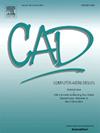P2Seg: Distance query from point to segments
IF 3.1
3区 计算机科学
Q2 COMPUTER SCIENCE, SOFTWARE ENGINEERING
引用次数: 0
Abstract
Querying the nearest distance from a point to line segments in 2D is a textbook problem in computational geometry. This paper presents P2Seg, a novel algorithmic strategy that transforms the intricate problem into an accessible linear traversal. Our method precomputes a KD tree and a Voronoi diagram for the site collection , where refers to the endpoints of all line segments. Obviously, for a query point , the nearest site provides a crucial clue for pinpointing the nearest line segment, i.e., the pairing effectively reduces the search from line segments to a limited number, represented as . The key idea of this paper is driven by an insightful observation: if the ray intersects with ’s Voronoi cell at a point, say , then is a subset of . This suggests that preprocessing efforts can be substantially minimized by focusing solely on scenarios where the query point lies on the Voronoi edges, which are fundamentally one-dimensional. We further prove that the challenge of locating the nearest line segment from can be distilled down to a simple linear traversal. Testing on datasets of varying complexities shows that P2Seg significantly outperforms state-of-the-art techniques. For example, in scenarios involving 10K segments with an average length of 0.5, our method runs 2.2 times faster than P2M and 60 times faster than AABB, as illustrated in the teaser figure.

P2Seg:从点到段的距离查询
查询2D中点到n个线段的最近距离是计算几何中的教科书问题。本文提出了一种新的算法策略P2Seg,它将复杂的问题转化为可访问的线性遍历。我们的方法为站点集合S预先计算了KD树和Voronoi图,其中S指所有线段的端点。显然,对于查询点q,最近的站点si为精确定位最近的线段提供了关键线索,即配对(q,si)有效地将搜索从n个线段减少到有限的数量,表示为L(q,si)。本文的关键思想是由一个深刻的观察驱动的:如果射线siq与si的Voronoi单元相交于一点,比如q ‘,那么L(q,si)是L(q ’,si)的子集。这表明,如果只关注查询点位于Voronoi边(基本上是一维的)的场景,预处理工作可以大大减少。我们进一步证明了从L(q ',si)找到最近的线段的挑战可以归结为一个简单的线性遍历。在不同复杂性的数据集上的测试表明,P2Seg明显优于最先进的技术。例如,在涉及平均长度为0.5的10K段的场景中,我们的方法比P2M快2.2倍,比AABB快60倍,如图所示。
本文章由计算机程序翻译,如有差异,请以英文原文为准。
求助全文
约1分钟内获得全文
求助全文
来源期刊

Computer-Aided Design
工程技术-计算机:软件工程
CiteScore
5.50
自引率
4.70%
发文量
117
审稿时长
4.2 months
期刊介绍:
Computer-Aided Design is a leading international journal that provides academia and industry with key papers on research and developments in the application of computers to design.
Computer-Aided Design invites papers reporting new research, as well as novel or particularly significant applications, within a wide range of topics, spanning all stages of design process from concept creation to manufacture and beyond.
 求助内容:
求助内容: 应助结果提醒方式:
应助结果提醒方式:


